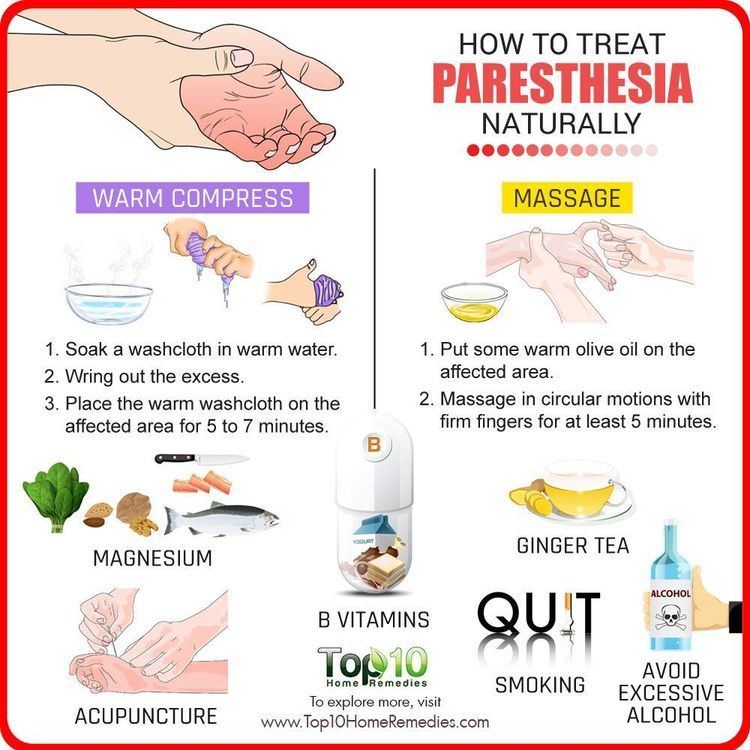Specialty Neurology ICD-9-CM 782.0, 355.1 MeSH D010292 | ICD-10 R20.2 DiseasesDB 24182 | |

Paresthesia is an abnormal sensation such as tingling, tickling, pricking, numbness or burning of a person's skin with no apparent physical cause. The manifestation of a paresthesia may be transient or chronic.
Contents
The most familiar kind of paresthesia is the sensation known as "pins and needles" or of a limb "falling asleep". A less well-known and uncommon but important paresthesia is formication, the sensation of bugs crawling underneath the skin.
Transient
Paresthesias of the hands, feet, legs and arms are common, transient symptoms. The briefest, electric shock type of paresthesia can be caused by tweaking the ulnar nerve near the elbow. Similar brief shocks can be experienced when any other nerve is tweaked (a tweaked neck nerve may cause a brief shock-like paresthesia toward the scalp). In the older age group, spinal column irregularities may tweak the spinal cord briefly when the head or back is turned, flexed, or extended into brief uncommon positions (Lhermitte's sign). The most common, everyday cause is temporary restriction of nerve impulses to an area of nerves, commonly caused by leaning or resting on parts of the body such as the legs (often followed by a pins and needles tingling sensation). Other causes include conditions such as hyperventilation syndrome and panic attacks. A cold sore outside the mouth (not a canker sore inside the mouth) can be preceded by tingling because a cold sore is caused by herpes simplex virus. The Varicella zoster virus (Shingles) also notably may cause recurring pain and tingling in skin or tissue along the distribution path of that nerve (most commonly in skin, along a dermatome pattern, but sometimes feeling like headache, chest or abdominal pain, or pelvic pain).
Other common examples occur when sustained pressure has been applied over a nerve, inhibiting or stimulating its function. Removing the pressure typically results in gradual relief of these paresthesias. Most pressure-induced paraesthesia results from awkward posture, such as engaging in Cross-legged sitting for prolonged periods of time.
Chronic
Chronic paresthesia indicates a problem with the functioning of neurons or poor circulation.
In older individuals, paresthesia is often the result of poor circulation in the limbs (such as in peripheral vascular disease), most often caused by atherosclerosis, the buildup of plaque within artery walls, over decades, with eventual plaque ruptures, internal clots over the ruptures and subsequent clot healing but leaving behind narrowing of the artery openings or closure, both locally and in downstream smaller branches. Without a proper supply of blood and nutrients, nerve cells can no longer adequately send signals to the brain. Because of this, paresthesia can also be a symptom of vitamin deficiency and malnutrition, as well as metabolic disorders like diabetes, hypothyroidism, and hypoparathyroidism. It can also be a symptom of mercury poisoning.
Irritation to the nerve can also come from inflammation to the tissue. Joint conditions such as rheumatoid arthritis, psoriatic arthritis, and carpal tunnel syndrome are common sources of paresthesia. Nerves below the head may be compressed where chronic neck and spine problems exist and can be caused by, among other things, muscle cramps that may be a result of clinical anxiety or excessive mental stress, bone disease, poor posture, unsafe heavy lifting practices or physical trauma such as whiplash. Paresthesia can also be caused simply by putting pressure on a nerve by applying weight (or pressure) to the limb for extended periods of time.
Another cause of paresthesia may be direct damage to the nerves themselves, i.e., neuropathy, which itself can stem from injury or infection such as frostbite or Lyme disease, or may be indicative of a current neurological disorder. Neuropathy is also a side effect of some chemotherapies (see Chemotherapy-induced peripheral neuropathy). Benzodiazepine withdrawal may also cause paresthesia as the drug removal leaves the GABA receptors stripped bare and possibly malformed. Chronic paresthesia can sometimes be symptomatic of serious conditions, such as a transient ischemic attack, or autoimmune diseases such as multiple sclerosis or lupus erythematosus. Exposure to environmental toxins, chemicals used in water treatment and fluoroquinolones can also cause paresthesia. Stroke survivors and those with Traumatic Brain Injury (TBI) may experience paresthesia from damage to the central nervous system.
The Varicella zoster virus disease (shingles) can attack nerves causing numbness instead of pain commonly associated with shingles. A diagnostic evaluation by a medical doctor is necessary to rule these out.
Acroparesthesia
Acroparesthesia is severe pain in the extremities, and may be caused by Fabry disease, a type of sphingolipidosis.
It can also be a sign of hypocalcemia.
Dentistry
Paresthesia or "persistent anesthesia" is a transient or potentially permanent condition of extended numbness after administration of local anesthesia and the injected anesthetic has terminated.
Potential causes include trauma induced to the nerve sheath during administration of the injection, hemorrhage about the sheath, type of anesthetic used, or administration of anesthetic potentially contaminated with alcohol or sterilizing solutions.
Other
Other causes may include:
Diagnostic approach
The nerve conduction study usually provides useful information for making diagnosis. A CT scan is sometimes used to rule out some causes from the central nervous system.
Treatment
Medications offered can include the immunosuppressant prednisone, intravenous gamma globulin (IVIG), anticonvulsants such as gabapentin or Gabitril and antiviral medication, depending on the underlying cause..
In addition to treatment of the underlying disorder, palliative care can include the use of topical numbing creams, such as lidocaine or prilocaine. Care must be taken to apply only the necessary amount, as excess can contribute to the condition. Otherwise, these products offer extremely effective, but short-lasting, relief from the condition. Paresthesia caused by stroke may receive some temporary benefit from high doses of Baclofen multiple times a day. HIV patients who self-medicate with cannabis report that it reduces their symptoms.
Paresthesia caused by shingles is treated with appropriate antiviral medication.
Etymology
The word paresthesia (/ˌpærᵻsˈθiːziə/ or /ˌpærᵻsˈθiːʒə/) (British English paraesthesia; plural paraesthesiae /ˌpærɪsˈθiːzɪiː/ or paraesthesias), comes from the Greek para ("beside", i.e., abnormal) and aisthesia ("sensation").
